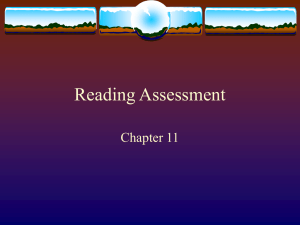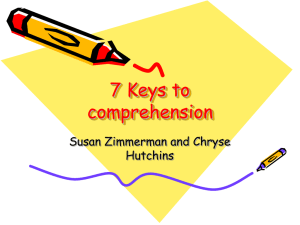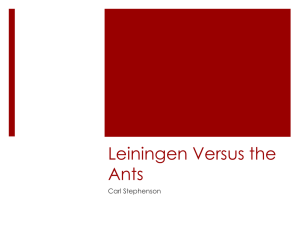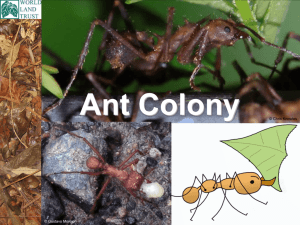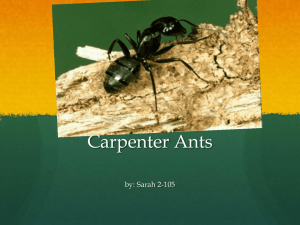PowerPoint
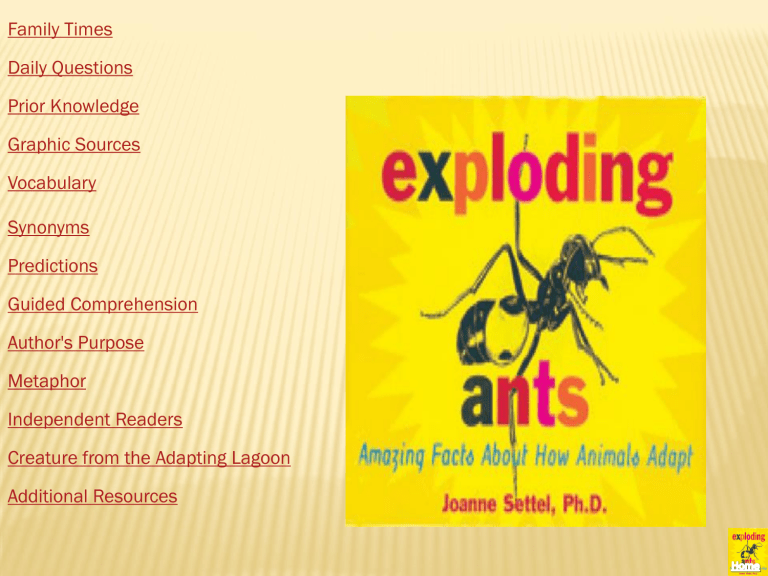
Creature from the Adapting Lagoon
Study Skills
Genre: Expository Nonfiction
Vocabulary Strategy: Context Clues
Comprehension Skill: Graphic Sources
Comprehension Strategy: Monitor and
Mix Up
Question of the Week:
How do animals adapt to survive?
Daily Questions:
What animal ways of eating and finding shelter seem especially gross?
How does the ability of a snake to gulp down prey larger than itself help it survive?
What traits do you have in common with the creature that you designed?
Ants
Animals
Activate Prior
Knowledge
Snakes
Owls
Graphic Sources
A graphic source, such as a picture, diagram, or chart, organizes information and makes it easy to see.
Preview the graphic sources in a selection to help you predict what you will be reading about.
As you read, compare the information in the text with the graphic source.
Monitor and Fix Up
Good readers make sure they understand what they read. If a graphic source is part of a text, you can use it to help you understand.
You can also use other references to help you.
If you do not understand a word, you can look it up in a dictionary. If you need more information about a subject, you can check an encyclopedia.
Write:
1. Read “Ant Facts.” Use both the text and the diagram to write a paragraph about an ant’s antennae. Tell what they look like and what they are for.
Include how to pronounce the word.
2. Use the diagram to write a description of the legs of an ant.
Critical
Enables
Vocabulary List
Mucus
Scarce
Predict Definitions:
Specialize
Sterile
Predict a definition for each word and write a sentence. Verify your predictions by looking up the word in a dictionary. If your sentences are incorrect, write ones that are correct.
Practice Sentences with Vocabulary: her to the store.
if you go hiking.
You should use ______________ jars and lids if you can your own food .
Critical
Being important to the outcome of a situation
Enables
Gives ability, power, or means to; makes able
Mucus
A slimy substance produced in the nose and throat to moisten and protect them.
Scarce
Hard to get; rare
Specialize
To develop in a special way.
Sterile
Free from germs
More Words to Know
Aborigines: the earliest known inhabitants of Australia
Nauseating: sickening; causing nausea
Predator: animal or person that lives by killing and eating other animals.
Practice Lesson Vocabulary:
Can mucus be found in the antennae or the mouth?
Is a sterile bandage clean or filthy?
Are water and food critical to adaptation or to survival?
Is water scarce in the desert?
Does an animal specialize in order to digest its food?
Is a frog’s slimy skin the main thing that enables it to catch insects?
Vocabulary Strategy:
Context Clues: Synonyms
Synonyms are different words that mean almost the same thing. Sometimes an author writes a synonym near a difficult word to help readers understand the word.
1. Read the words and sentences around the unknown word. Is there a synonym?
2. To help find synonyms, look for or like, or look for a word set off by commas.
3. Try using the synonym in place of the unknown word. Does this meaning make sense?
4. If these tips do not help, look up the unknown word in the dictionary or talk with a friend about it.
As you read “Small but Mighty,” check the context of words you don’t know.
See if a nearby synonym gives a clue to a word’s meaning.
Genre: Expository Nonfiction
Expository nonfiction explains what certain things are and how they came to be or behave. As you read, notice how the author explains insect behavior.
How do insects adapt to find food, shelter, and safety?
Preview and Predict
Preview the graphic sources and discuss the topics they think this selection will cover. Use lesson vocabulary words as you talk about what you expect to learn.
Guided Comprehension:
Look at the photo of the lizard and snake on p. 442. What information does it provide?
Why is it important for species to specialize in where they live or what they eat?
What is the author’s purpose on p. 444, paragraphs 1-3?
What does the picture at the top of pp. 444-445 illustrate?
What is a synonym for the word mandibles on p. 446? How do you know?
What do Camponotus ants and Globitermes sulfureus termites have in common?
Explain why adaptation is important for all animal species, not just insects.
Guided Comprehension Continued?
What do the illustrations on p. 448 show you about owls that the text does not?
What causes owls to spit up pellets?
The author’s main purpose with this selection is to inform. What additional purpose does she have? Explain.
Why can a snake eat large prey whole?
What animal adaptations have you observed or heard about in the world around you?
Honey Ants
Exploding Ants
Owl and Owl Pellets
Author’s Purpose
Authors write for one or more reasons.
Author’s purpose can affect the way you read and comprehend text.
The descriptions of honey ant nests and repletes on p. 444, paragraphs 1-3, contain many facts that need to be read carefully to understand. This lets you know the author is writing to inform.
Identify text features that indicate that the author is writing to inform.
Metaphor
A metaphor is a comparison between two unlike things that are alike in at least one way.
In a metaphor, the similarity is implied – not stated using words of comparison.
A metaphor calls attention to certain qualities of one or both things being compared.
Reread pp. 444-445. Notice the metaphor comparing repletes to “living honey jars.”
Working in small groups, write your own metaphors comparing an animal in the selection to something else.
SUMMARY
This book surveys various birds from around the world. It identifies and describes different bird groups, including sea birds, shore birds, birds of prey, and song birds. It describes their habitats, eating habits, behavior, and physical make-up.
COMPREHENSION QUESTIONS
PAGES 4–5 How have birds evolved into “flying machines”?
PAGES 6–7 What do these photos show you?
PAGES 10–11 What is the main idea? What are the supporting details?
PAGE 14 What are some of the owl’s special adaptations?
PAGE 22 What are some challenges that birds face?
SUMMARY
This book presents information about various world habitats, such as the Antarctic, tropical forests, grasslands, and temperate forests and the animals that live in these areas. The emphasis is on how animals adapt to their environments.
COMPREHENSION QUESTIONS
PAGE 4 In the second paragraph, what is the main idea?
What are the supporting details?
PAGE 15 Use the map to determine the continents on which grasslands are found.
PAGES 16–17 What animals do you see in the photos?
What did you learn about these animals in the text? Find the African grasslands on the map.
PAGE 19 How has the black-tailed Jack Rabbit adapted to life in the desert?
PAGE 21 Why do you think so many different types of plants and animals live in tropical rain forests?
SUMMARY
This book presents information about research on deepspace travel and the adaptations humans would have to make to sustain long voyages. It explores benefits and drawbacks of space travel and colonization. Information is included about early space voyages and scientific research on other planets.
COMPREHENSION QUESTIONS
PAGE 8 Why do scientists think Mars is the most likely planet to support life?
PAGES 10–11 Why is zero gravity a problem for humans?
PAGE 14 What are some of the benefits of building space colonies?
PAGE 15 What is the topic of the circle graph?
Genre: Experiment
• Experiments tell how to perform a trial or test to find out about something.
• Most experiments deal with some kind of science.
Text Features:
• The author begins by stating the purpose of the experiment and the materials needed to perform it. Then come step-by-step instructions, from start to finish.
• Scan the steps to get an idea of what the experiment is about.
How can you tell that this is a serious scientific experiment?
How do the step-by-step instructions help you understand the experiment?
How do the illustrations help you imagine the experiment?
How can you organize the criteria?
Read Across Texts
Choose one of the creatures from Exploding Ants and look at the list of criteria on page 456 in this experiment.
Make a similar list of criteria for the creature you chose, using facts from Exploding Ants.
Writing Across Texts:
Write your list of criteria and read it to the class. See if people can visualize your creature from your list of criteria.



